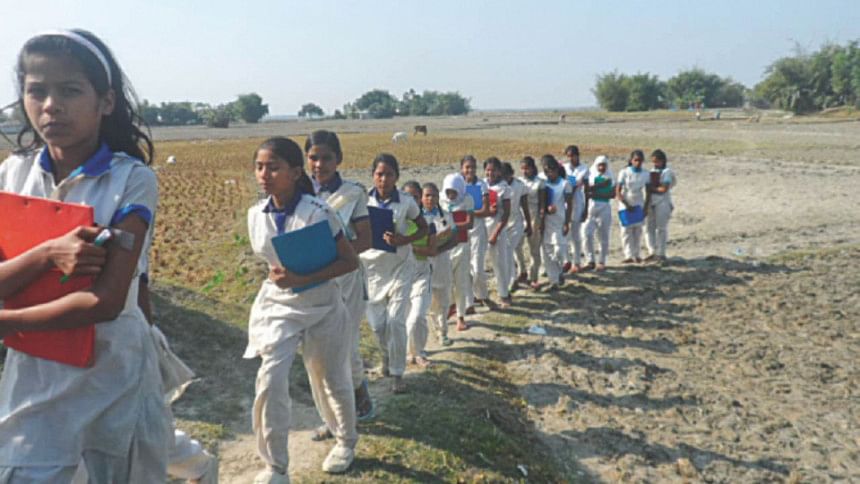The emerging positives of Bangladesh

Recently, the well-known Boston Consulting Group wrote a piece entitled 'Bangladesh – the surging consumer market nobody saw coming'. It categorically states that the country is emerging as the 'world's next growth opportunities for consumer product companies'. Incredibly, every year about two million Bangladeshis join the ranks of the middle class and the affluent. This surge is seen as reflecting the quick graduation of Bangladesh to the level of a low middle income country from that of a least developed country. Policymakers in Bangladesh predict that the country would graduate to a middle income country with $5000 + per capita in another five years. By 2025, about 30 million people will join the middle class here.
Bangladesh's heretofore growth story was unfortunately overshadowed by the growth story of neighbouring India. But the reasons behind Bangladesh's own success story are fast becoming apparent. The fact that microcredit has spawned all over the country but has not affected inflation is another great sub-story. Besides garment manufacturing, footwear, pharmaceuticals and IT services have led the country to reap immense benefits. A consumer society whose median age will just be 24 in the near future will do wonders for manufacturers, whose consumer base will expand significantly. Add to this, the burgeoning foreign remittance of Bangladeshi workers and professionals now working abroad. Not only the spending, but the cash backup works as a mix for consumer expenditure in quality goods.
Yet the Bangladesh story does not end there. From 2000, the country pulled its shoestring and began to rise, making significant improvements in the basic condition of people's lives. Life expectancy began to improve, and now stands at 70 years. The country can pride itself on having overtaken the life expectancy of neighbouring India by five years. This is in spite of India's citizens having more per capita income. Bangladesh has also taken giant steps in improving health and education. Today girls' education has crossed 95 percent, surpassing the education level of boys. Another great progress is in infant mortality. Child mortality has also more than halved and is now falling more rapidly. Maternal mortality has fallen by two-thirds. Today females live two years more than males. A unique phenomenon in Bangladesh today is that the rate of poverty reduction is more than the rate of growth per year. All this is the secret behind Bangladesh's growth story.
Several factors seem to have contributed to this success. Birth control in Bangladesh has never been coercive; it has always been voluntary. This has encouraged couples and especially mothers to understand the path they need to take to build a happy family. Today, the fertility rate is 2.3, which is slightly above the replacement level. Add to this the widespread growth of female education. Two other phenomena have buttressed this achievement. The boom in the garment industry – Bangladesh is now the second largest garment exporter in the world just behind China, a behemoth in this field. The other is the introduction of microcredit that fuelled the income of women in the entire country. These two growth elements have pumped money into the pockets of women who have spent mainly on health, education and nutritious food. This combination is so potent that it can be dubbed as the 'Bangladesh magic' behind growth.
Meanwhile, food production in this tiny country has grown three times since 1971. What was the international basket case of Henry Kissinger of yore is turning into an almost food exporting nation. The Bangladeshi farmer is also diversifying crop production into vegetables and fruits as well as exotic food items. An extraordinary strategy used by Bangladeshi farmers was the use of high yielding seeds and irrigation to grow crops, turning the winter crop (Boro) into the largest yielding crop season.
The phenomenal growth of Bangladesh can also be attributed to the huge amount of foreign remittances sent by 10 million expatriate Bangladeshis. These remittances are serious money in the pockets of families and are spurring trade as well as small scale industries. A fascinating phenomenon of Bangladesh is that the diaspora does not belong to the poor families only. The middle income professionals are also a part of it.
The social safety programmes have leapfrogged and is now 12 percent of the GDP in the country. The present government of Sheikh Hasina is particularly sensitive to the needs of the vulnerable people in society. The Bangladesh society is now going through a rebalancing exercise. In spite of the country's cantankerous politics, there is a consensus in favour of social programmes. The other extraordinary phenomenon of Bangladesh is the expansion in the growth of non-governmental organisations (NGOs). From the global giants, the Grameen Bank and BRAC, there seems to be an NGO for all worthy causes in Bangladesh.
Yet two aspects of Bangladesh are disappointing. The first is corruption. Like measles, it has pockmarked the society. It is not only a rent seeker but a policy drifter too. It contorts and deflects priorities. It becomes virulent at times. The other is dysfunctional politics. People are politically conscious but there are politicians and professionals who serve their own interests more than that of society. The government under the Prime Minister is trying to contain corruption by introducing digital technology in delivering goods and services. One of the remarkable things in this sphere is the use of the internet for government procurement and collection of revenue rather than for tendering and solicitation. About 20 percent of government purchases take place through the internet. But the use of digital technology needs to be sped up. Bangladesh needs course correction fast to achieve Bangabandhu's Sonar Bangla.
The writer is a former Ambassador and commentator on critical issues.
E-Mail [email protected]

 For all latest news, follow The Daily Star's Google News channel.
For all latest news, follow The Daily Star's Google News channel. 



Comments